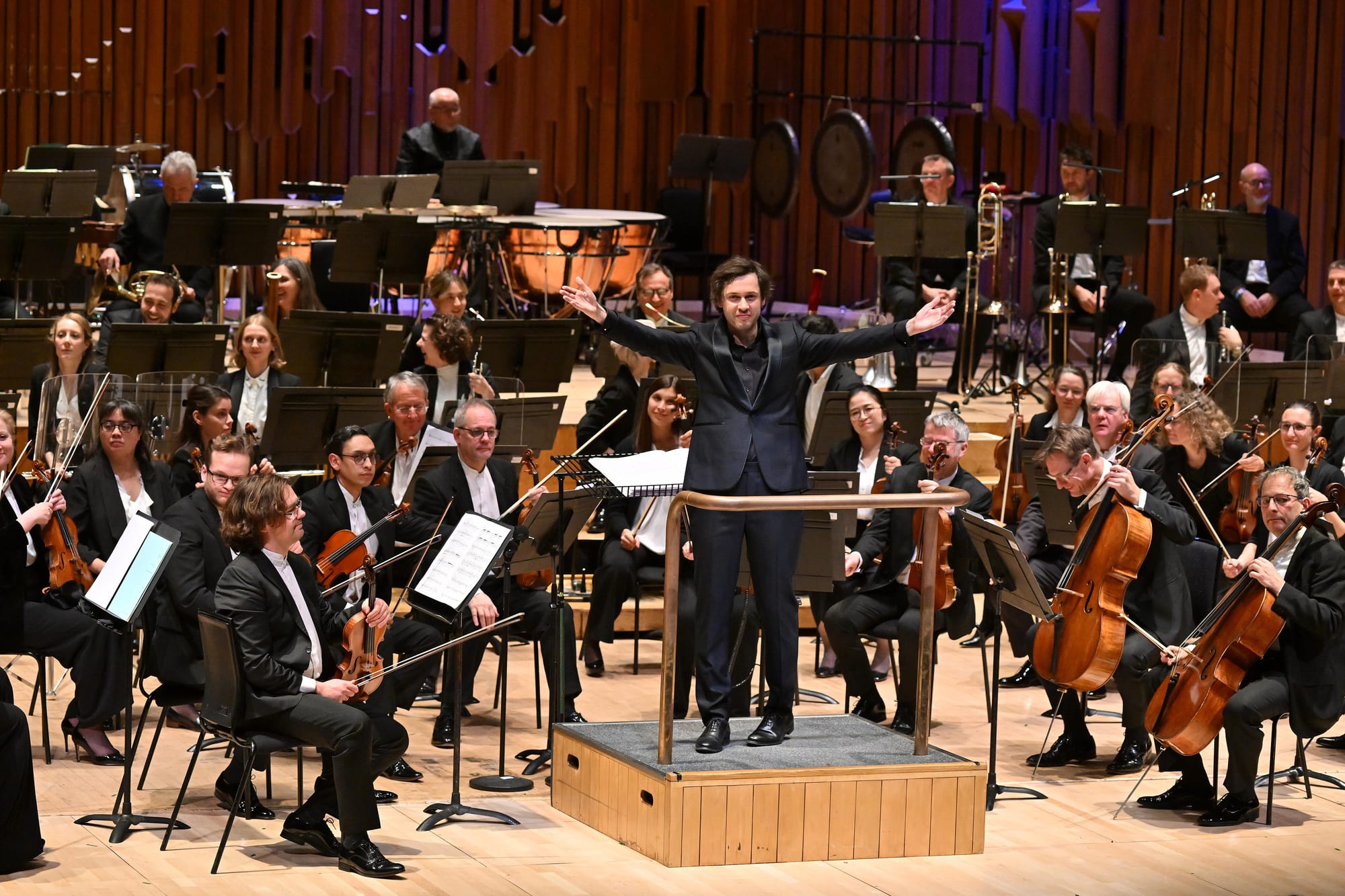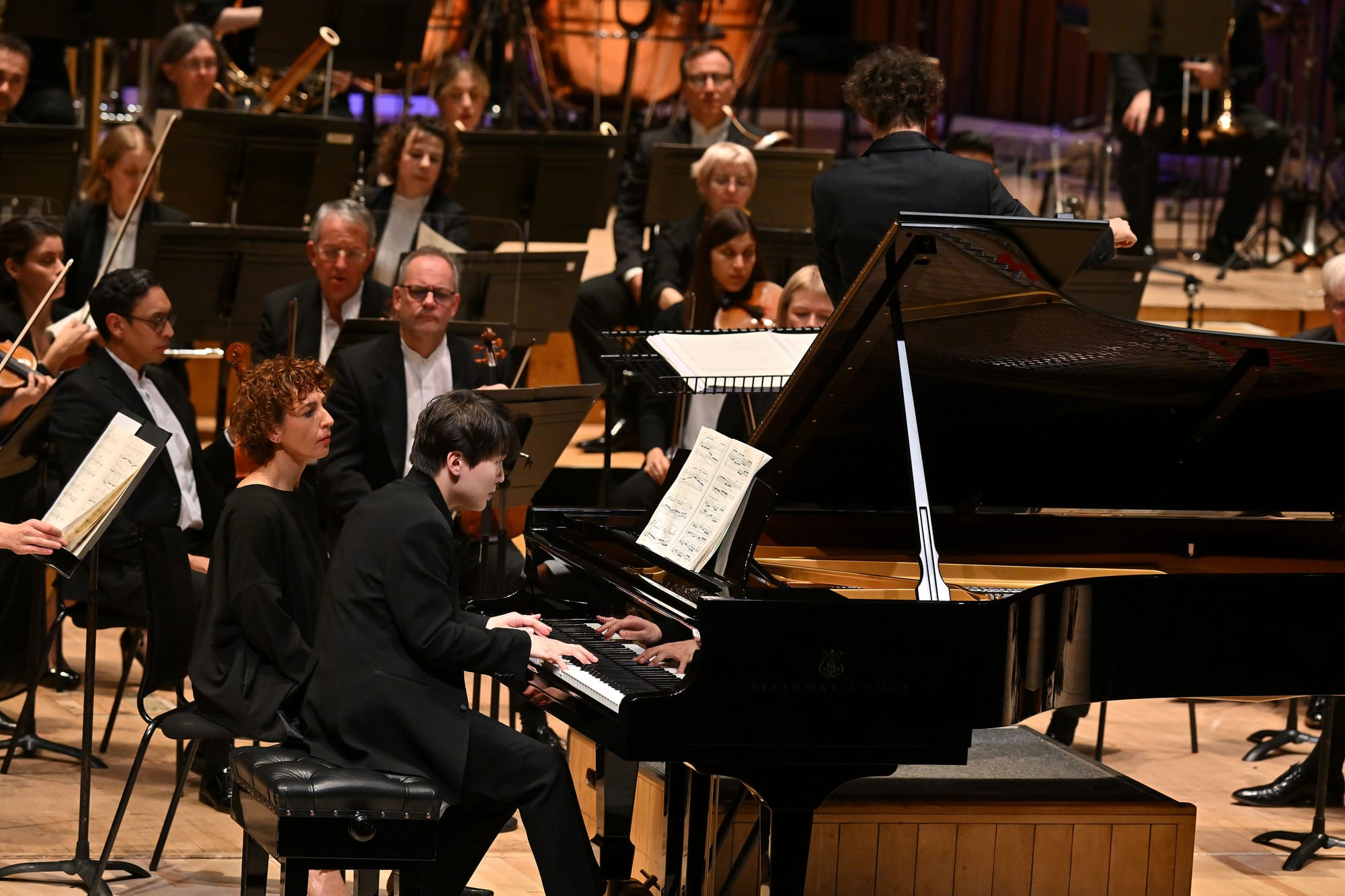LSO Futures: London's Bright Light of Hope

LSO Futures; Seong-Jin Cho Artist Portrait. Seong-Jin Cho (piano); London Symphony Orchestra / Maxime Pascal (conducto). Barbican Hall, London, 20.11.2025
Omri Kochavi gilufim (2024/25, LSO Helen Hamlyn Panufnik Commission, World Premiere
Sasha Scott Sly (2024/25, LSO Helen Hamlyn Panufnik Commission, World Premiere
Donghoon Shin Piano Concerto (2025, World Premier, LSO co-commission
Boulez Rituel in memoriam Bruno Maderna (1974/5)
In 2004, Camilla Panufnik suggsted a scheme in memoy of he lat husband, Andrzej Panufnik which allows young composer to wok wih on of th World's op ochestras; Colin Mathews was invited to be Composition Director in 2005. To date, 117 composers have worked with th LSO first-hand. Six composers work with the LSO each year with a piece of three to four minute duration. A sequence of compact discs has been released under the title 'Panufnik Legacies'. From the six selected pieces, two are selected for premiere at he Barbican in extended format. Films punctuated the evening, from Lady Panufnik, and the composers themselves.
Born in 1994 in Israel, Omar Kochavi is based in London. . His piece Kushatos (to a text by Amira Hess), premiered at Snape by the BBC Singers and Owain Park, was nominated fo a 2023 Ivors Classical Award:
Kochevi's gilufim, performed here, takes as is starting point the Hebrew word for 'carvings'. The musical process mirrors that of sculpture, in that music is carved away, rather than accrued: one initial sketch provided the material fo everything we heard. And wood, intensely related to sculpture, informs the sounds we hear: strings play with wooden mutes, while a marimba offers a motoric, quasi-Minimalist presence in the work's first part. It is not only carving that is wood-related: there is also a reference to burning: the first marking is 'gentle and vibrant, like firewood,' while in the central part, percussion create the impression of a crackling fire. As a sonic experience, Kochavi works towards an impression of the music coming ino focus, shorn of mutes.
The opening seemed surprisingly lyrical (although this seems to be a Kochari trait: listen to the soprano lines in his Nahar Amok - 'Deep River' - in this performnce:
The idea of the music focusing itself works well, too, and Kochavi has a fine ear for orchestration, while the quasi-Minimalism gives the music drive. This is a good, if not indelibly memorable, piece. No caveats about the performance; modern music is Maxime Pascal's daily bread, and he led the LSO wih unshakable confidence.
UK composer Sasha Scott was born in 2002; she is a violinist as well as a composer and plays regularly with Chineke! and the London Contemporary Orchestra; she is Royal College trained, where she studied under Mark-Anthony Turnage, and she was a winner of the 2019 BBC Young Composer of the Year.
Scott seems to have a phenomenal imagination and the tool to realise it: try her down the rabbit hole for cello and electronics, for example, a magpie piece that mirrors her varied musical experiences thus far, or the electronic piece Humans May Not Apply:
Her Sly has the intention of sounding 'slightly devious and shifting'. It invokes the moment of waking, when dream emotions can linger. The work is imbued by a sense of foreboding ('paranoia' in the composer's words, 'as if something is creeping just below the surface'). Thus it is the dream state is foregrounded at the start, the sounds including flute breaths (the flute blown into but with no tangible pitch emerging). Waking comes after a vivid dream, via piano and vibaphone chimes (the bleed into reality is captured by a harp glissando created via screwdriver). The darker sections are most impressive: growling brass, foreboding low strings. She plays, too, with expectation (unsuprisingly, given the work's basis). Punctuating chords against a bass pedal make for maximal impact; there is a massive talent here.
Donghoon Shin (born 1983, South Korea) was himself part of the scheme previously, and his visceral and colouful In this Valley of Dying Stars was included on the LSO Live's The Panufnik Legacies III (it is a terrific piece given in a blazing performance under François-Xavier Roth) The Piano Concerto (an LSO co-commission) is dedicated to Cho, and even tries to capture Cho's character. It is also deeply influenced by the Floresan and Eusebius parts of Schumann's persona (which map onto Cho's quiet off-stage demeanour and his prrsence on-stage). Shin therefore experiments with contrasts and their interactions (including tonal and atonal). Although there is a ghost structure of a traditional concerto (sonata form, ternary slow movement and rondo), there is significant distension. While the first panel of thr piece celebrates duality, the second is a funeral march, while the finale is a 'twisted rondo'. As Shin says about this finale, 'it's as if one were dreaming a strange, surreal dream – part nightmare, part comedy, part farce, part tragedy,' while on the filmed segment, Shin said the slow movement was 'almost screaming' and a 'portrait of myself'.
There is a supeb grasp of compositional technique here: Shin knows exactly what he wants to say, and how to say it. Quotes and near-quotes are seamlessly interwoven at times; at others, they seem to just appear. Cho bought a ferocious technique, but also magnificent beauty to the party, climaxing in the most extraordinary cadenza. Jazz references met High Romanticism met Modenism in a score of huge remit: here, one finds extremes of beauty against almost superhuman ferocity, all rounded off by a madcap finale full of humour. An extraordinary piece. Cho was superb, but so was the LSO and Pascal; they played the piece as if completely at home, ensemble was water-tight. This is a fuily extended concerto (over 35 minutes) and sits, in the hierarchy of contemporary concertos, up there with Rebecca Saunders' Piano Concerto.

That was quite the first half; just under half an hour's music for the second, Pierre Boulez' Rituel (dedicated to Bruno Maderna and further dedicated here, by Pascal, to the memory of Pierre Boulez). One of Boulez' true masterpieces (among many), Rituel is also one of his most approachable pieces, or at least when heard live where the spatial layout clarifies much, with the ritualistic gongs at the back and the groupings of instrument(s) and percussion around the stage. Pascal suggested that each melody is offered as 'a prayer'. This is piece that requires maximum attention to ensemble to work: in the opening minutes, there is an upward, short gesture that is passed around the players by group. Perhaps the brass component was just a touch lazy on fist showing (it was far tighter later), but that aside this felt a faultless performance. Although wind, brass and percussion-dominated, there was some terrific playing from the string group. The gong players understandably had a field day, but it was the totality of all that counted most, culminating in a close carrying a palpable weight of grief. This piece is a ritual, through and through, and how powerful its effect here. A perfect reminder of Boulez' genius.
Her's a performance by he BBC symphony Orchestra under the baton of Pierre Boulez himself (includes rolling score):
How fresh and stimulating to experience new music at this level; to be stimulted, and challenged. If only there were concerts like this every week …
There is no doubt the LSO Helen Hamelyn Panufnik Composers' Scheme is a bright light in the UK today (its title is a bit of a mouthful, though). This year is its 20th anniversary: may there be many more.
